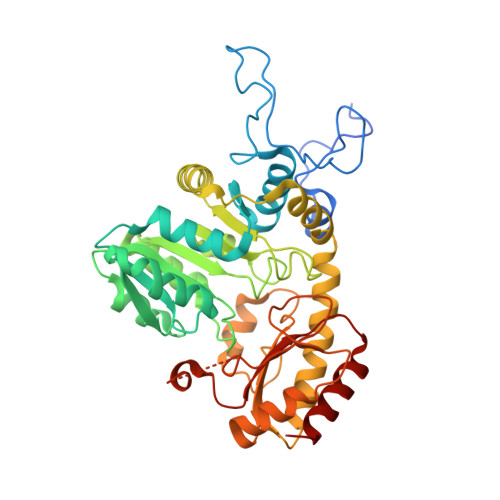Structural basis of the inhibition of cystathionine gamma-lyase from Toxoplasma gondii by propargylglycine and cysteine.
Fernandez-Rodriguez, C., Conter, C., Oyenarte, I., Favretto, F., Quintana, I., Martinez-Chantar, M.L., Astegno, A., Martinez-Cruz, L.A.(2023) Protein Sci 32: e4619-e4619
- PubMed: 36883335
- DOI: https://doi.org/10.1002/pro.4619
- Primary Citation of Related Structures:
7NL1, 8BIS, 8BIU, 8BIV, 8BIW, 8BIX, 8BIZ - PubMed Abstract:
Cystathionine γ-lyase (CGL) is a PLP-dependent enzyme that catalyzes the last step of the reverse transsulfuration route for endogenous cysteine biosynthesis. The canonical CGL-catalyzed process consists of an α,γ-elimination reaction that breaks down cystathionine into cysteine, α-ketobutyrate, and ammonia. In some species, the enzyme can alternatively use cysteine as a substrate, resulting in the production of hydrogen sulfide (H 2 S). Importantly, inhibition of the enzyme and consequently of its H 2 S production activity, makes multiresistant bacteria considerably more susceptible to antibiotics. Other organisms, such as Toxoplasma gondii, the causative agent of toxoplasmosis, encode a CGL enzyme (TgCGL) that almost exclusively catalyzes the canonical process, with only minor reactivity to cysteine. Interestingly, the substitution of N360 by a serine (the equivalent amino acid residue in the human enzyme) at the active site changes the specificity of TgCGL for the catalysis of cystathionine, resulting in an enzyme that can cleave both the CγS and the CβS bond of cystathionine. Based on these findings and to deepen the molecular basis underlying the enzyme-substrate specificity, we have elucidated the crystal structures of native TgCGL and the variant TgCGL-N360S from crystals grown in the presence of cystathionine, cysteine, and the inhibitor d,l-propargylglycine (PPG). Our structures reveal the binding mode of each molecule within the catalytic cavity and help explain the inhibitory behavior of cysteine and PPG. A specific inhibitory mechanism of TgCGL by PPG is proposed.
Organizational Affiliation:
Center for Cooperative Research in Biosciences (CIC bioGUNE), Basque Research and Technology Alliance (BRTA), Derio, Spain.
















